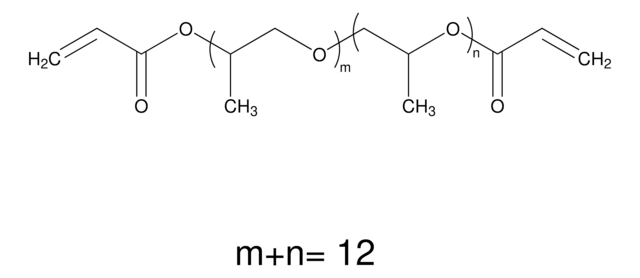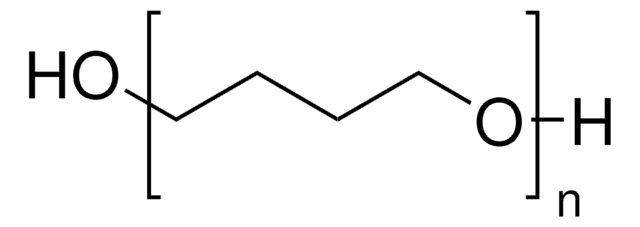202312
Poly(propylene glycol)
average Mn ~725
Sinónimos:
PPG, Poly(propylene oxide)
About This Item
Productos recomendados
densidad de vapor
>1 (vs air)
Nivel de calidad
presión de vapor
<0.01 mmHg ( 20 °C)
mol peso
average Mn ~725
contiene
130-190 ppm proprietary phenolic antioxidant
índice de refracción
n20/D 1.449
viscosidad
115 cSt(25 °C)(lit.)
valor hidroxilo
147 mg KOH/g
solubilidad
water: miscible (completely)
densidad
1.007 g/mL at 25 °C
cadena SMILES
CC(O)CO
InChI
1S/C6H14O3/c1-5(8)4-9-6(2)3-7/h5-8H,3-4H2,1-2H3
Clave InChI
DUFKCOQISQKSAV-UHFFFAOYSA-N
¿Está buscando productos similares? Visita Guía de comparación de productos
Categorías relacionadas
Aplicación
- Recycling of waste materials: Utilization of propylene glycol in the recycling of waste poly(vinyl chloride) to enhance the mechanical properties of new polymer composites (Hilary et al., 2021).
- Dental composite improvement: Enhancement of dental composites′ conversion rates through the use of poly(propylene glycol) and urethane dimethacrylates, while also examining cytocompatibility (Walters et al., 2016).
- 3D printing of scaffolds: Use of poly(propylene fumarate) and propylene glycol in 3D printing of resorbable tissue engineering scaffolds, demonstrating innovation in medical applications (Childers et al., 2015).
Código de clase de almacenamiento
10 - Combustible liquids
Clase de riesgo para el agua (WGK)
WGK 1
Punto de inflamabilidad (°F)
445.0 °F - closed cup
Punto de inflamabilidad (°C)
229.44 °C - closed cup
Equipo de protección personal
Eyeshields, Gloves
Elija entre una de las versiones más recientes:
¿Ya tiene este producto?
Encuentre la documentación para los productos que ha comprado recientemente en la Biblioteca de documentos.
Los clientes también vieron
Nuestro equipo de científicos tiene experiencia en todas las áreas de investigación: Ciencias de la vida, Ciencia de los materiales, Síntesis química, Cromatografía, Analítica y muchas otras.
Póngase en contacto con el Servicio técnico





